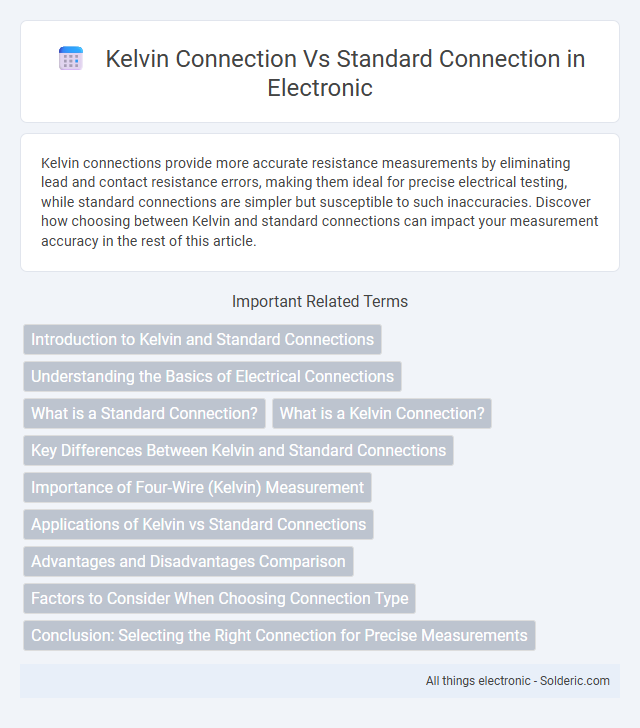Kelvin connections provide more accurate resistance measurements by eliminating lead and contact resistance errors, making them ideal for precise electrical testing, while standard connections are simpler but susceptible to such inaccuracies. Discover how choosing between Kelvin and standard connections can impact your measurement accuracy in the rest of this article.
Comparison Table
| Feature | Kelvin Connection | Standard Connection |
|---|---|---|
| Definition | Four-wire technique minimizing lead resistance effect | Two-wire technique measuring total resistance including lead wires |
| Accuracy | High accuracy, eliminates lead and contact resistance errors | Lower accuracy, affected by lead and contact resistance |
| Usage | Precision low-resistance measurements (e.g., shunts, strain gauges) | General resistance measurements where lead resistance is negligible |
| Complexity | More complex wiring with four contacts | Simple wiring with two contacts |
| Cost | Higher cost due to additional contacts and instrumentation | Lower cost and simpler equipment |
| Lead Resistance Effect | Negligible, as voltage sensing leads bypass test current | Significant, leads add to measured resistance |
Introduction to Kelvin and Standard Connections
Kelvin connections use separate pairs of current and voltage leads to eliminate the effect of lead and contact resistance during precise electrical measurements, ensuring higher accuracy compared to standard connections. Standard connections combine current and voltage leads in a single path, which can introduce measurement errors due to voltage drops along the leads. Kelvin connections are essential in four-wire sensing applications where accurate resistance measurement of low-value components is critical.
Understanding the Basics of Electrical Connections
Kelvin connection enhances measurement accuracy by using separate pairs of wires for current and voltage, eliminating errors caused by contact and lead resistances. In contrast, standard connection uses a single pair of wires, which can introduce voltage drops and distort readings during low-resistance measurements. Ensuring your setup employs Kelvin connection can significantly improve precision in environments where accurate electrical measurements are critical.
What is a Standard Connection?
A standard connection involves a direct electrical link where the lead wires connect straight to the measurement device, typically causing resistance and voltage drops to affect accuracy. This setup is common in simple circuits but can lead to measurement errors due to the influence of lead wire resistance. In contrast, Kelvin connections use separate force and sense leads to eliminate the impact of lead resistance, providing highly precise voltage and current measurements.
What is a Kelvin Connection?
A Kelvin connection is a four-wire measurement technique designed to eliminate the effects of lead and contact resistance in electrical measurements. It uses separate pairs of current-carrying and voltage-sensing leads, allowing precise voltage measurement directly across the test resistor without the influence of resistance from the test leads. This method is essential in applications requiring accurate low-resistance measurements, such as in precision sensors and electrical component testing.
Key Differences Between Kelvin and Standard Connections
Kelvin connections use separate pairs of wires for current and voltage measurements, eliminating errors caused by lead and contact resistances in precision low-resistance measurements. Standard connections combine current and voltage paths, which can introduce measurement inaccuracies due to voltage drops along the test leads. Choosing a Kelvin connection ensures more accurate and reliable results in your electrical testing, especially when measuring very low resistances.
Importance of Four-Wire (Kelvin) Measurement
Four-wire (Kelvin) measurement is crucial for eliminating errors caused by lead and contact resistance in precision electrical measurements. By using separate pairs of current-carrying and voltage-sensing wires, the Kelvin connection ensures accurate voltage readings across the test element, regardless of lead resistance. This method significantly enhances measurement accuracy in low-resistance scenarios compared to standard two-wire connection techniques.
Applications of Kelvin vs Standard Connections
Kelvin connections are primarily used in precision low-resistance measurements where accuracy is critical, such as in battery testing, semiconductor characterization, and high-current shunt measurements. Standard connections are suitable for general-purpose applications where slight measurement errors caused by lead and contact resistance are acceptable, like typical voltage or current monitoring. Your choice of Kelvin connection ensures minimized error due to parasitic resistance, essential in high-precision electronic testing environments.
Advantages and Disadvantages Comparison
Kelvin connection offers superior accuracy in low-resistance measurements by eliminating lead and contact resistance errors through separate current and voltage paths, making it ideal for precision applications. Standard connections are simpler and less costly but suffer from measurement inaccuracies due to combined resistance of leads and contacts, reducing reliability in sensitive measurements. However, Kelvin connections require more complex wiring and instrumentation, which can increase setup time and cost, whereas standard connections are easier to implement but provide less precise results.
Factors to Consider When Choosing Connection Type
When selecting between Kelvin connection and standard connection, consider accuracy requirements and measurement conditions since Kelvin connections minimize lead resistance effects ideal for precise low-resistance measurements. Evaluate environmental factors such as temperature fluctuations and EMI, as Kelvin connections offer enhanced noise immunity for sensitive applications. Cost and complexity also influence the choice, with standard connections being simpler and more economical but less accurate under demanding conditions.
Conclusion: Selecting the Right Connection for Precise Measurements
Kelvin connection offers superior accuracy by eliminating lead and contact resistance, making it ideal for precise low-resistance measurements. Standard connections may suffice for general applications but often introduce errors in sensitive measurements. Choosing the right connection ensures Your results are reliable and accurate, especially in critical electronic testing scenarios.
Kelvin connection vs standard connection Infographic

 solderic.com
solderic.com